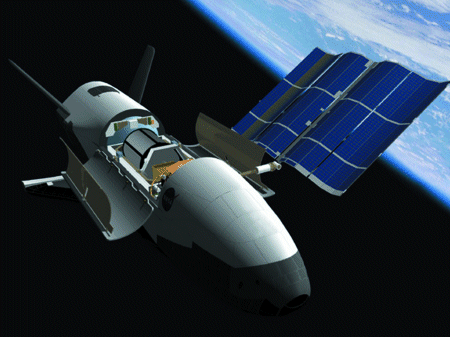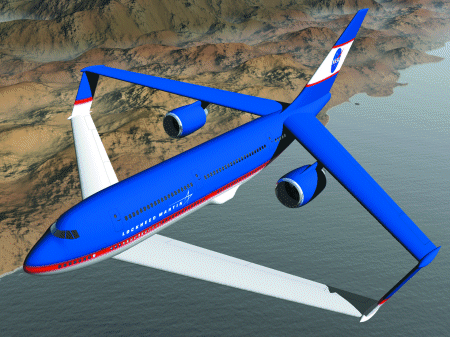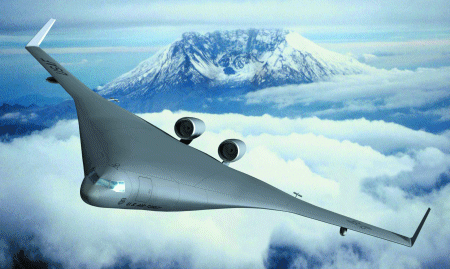GRAHAM WARWICK / WASHINGTON DC
NASA is restructuring its aerospace research in the face of budget pressures and demands from US industry for more support for aeronauticsUS aerospace research and development is at a crossroads. The industry's engine of innovation, NASA, is stalled by budget overruns on the International Space Station (ISS) and beset by criticism of its investment priorities. The agency has launched a fundamental revamp of its research agenda, but could be pre-empted by Congress' increasing concern that the USA is losing its technology edge.
NASA, facing cost overruns on the Space Station of between $4.8 billion and $5.4 billion, has been instructed by the new Bush Administration to make the cuts necessary to stay within the $25 billion programme cap (see P30). While the ISS itself is taking the deepest cuts, the consequences are being felt across the agency.
The problems are evident in the confusion surrounding NASA's experimental vehicle programmes, most of which are directly or indirectly threatened by budget pressures and shifting priorities. Directly affected is the X-38 programme, which is demonstrating technologies for a Space Station crew return vehicle (CRV). A seventh X-38 air-drop test was conducted successfully on 10 July, but the in-space test planned for 2003 is unfunded following the decision to shelve the CRV as part of the ISS cuts.

The X-37 reusable spaceplane technology demonstrator is also threatened indirectly. Boeing is continuing to develop this under a 1999 co-operative agreement with NASA which calls for drop tests to begin next year, but there is no funding for the orbital tests due in 2004. NASA has not yet decided whether to fund the X-37 under its new Space Launch Initiative (SLI) programme, which aims to develop technology for a second-generation reusable launch vehicle (RLV) to replace the Space Shuttle.
The Lockheed Martin X-33 and Orbital Sciences X-34 RLV technology demonstrators were cancelled earlier this year, before either had flown, after NASA determined their continuation was not the best use of funds under the five-year, $4.85 billion SLI. Both programmes had experienced substantial technical delays and cost overruns. Meanwhile, the USAir Force is interested in picking up the X-33, the X-34 and, possibly, increasing its role in the X-37 programme, but has yet to make a decision.
Experimental aircraft programmes are faring no better under budget pressures. NASA's Revolutionary Concepts (RevCon) programme, launched in 1999 as a way to encourage development of experimental aircraft such as blended wing-body and joined-wing transports, has been stalled by the debate over the agency's aeronautics research spending, which industry argues has slipped below acceptable limits.
The X-43 Hyper X programme remains grounded while investigators determine what caused the hypersonic research vehicle's booster to fail seconds into its first flight on 2 June. Meanwhile, under its Environment Research Aircraft and Sensor Technology (ERAST) programme, NASA is racing to fly the Helios solar-powered unmanned air vehicle (UAV) to 100,000ft before time and money run out.
Playing a key role
Experimental air and space vehicles have played a key role in US aerospace development since the Bell X-1 broke the sound barrier in 1947.
NASA's restructuring of its aerospace research activities was heralded with the unveiling of the agency's $14.5 billion fiscal year 2002 budget request in early April, which saw aeronautics and space research programmes being combined under a single aerospace technology enterprise. At the same time, research was refocused on long-term, "leapfrog" technologies and several near-term, product-related programmes were terminated.
Defending the changes before Congress, NASA Administrator Dan Goldin noted that reduced defence spending and increased industry consolidation have substantially reduced the infrastructure supporting US aerospace research and technology. "R&D in the aerospace industry is typically 3-5% of sales. Much is focused on evolutionary product development. This contrasts with other industries," he said, citing the computer and pharmaceutical sectors. "Therefore, at NASA, we shifted our technology development toward revolutionary long-term, high-risk civil needs."
As the USA's largest aerospace company, Boeing views "with concern" the decline in government investment in aerospace technology, "especially funding related to aeronautics in NASA and the DoD [Department of Defence]", chief technology officer David Swain told Congress. Such cuts mean less opportunity to develop technology initiatives and prototype demonstration programmes and also "to attract and engage a new generation of aerospace talent".
Boeing believes experimental prototypes not only demonstrate new technologies but also push engineers to use new tools, practise new processes and develop engineering skills. So the company "strongly endorses" Golding's goal "to reinvigorate NASA's role as the enabler of breakthrough aerospace research," Swain said.

Integrated approach
"We strongly support focused NASA efforts that integrate breakthough technologies for system solutions," Swain said. "Each of Boeing's top aeronautics research and technology priorities demand and benefit from the synergies of an integrated approach." The company's top three are 21st century air vehicle technology, the SLI and air traffic management.
Of the three priorities, the SLI is most likely to generate a slew of new X-vehicles, continuing the recent trend towards experimental space vehicles and away from experimental air ones. These have included the cancelled X-33 and X-34, the X-38 and the X-40 space manoeuvre vehicle, a subscale precursor to Boeing's X-37. The seventh and final air drop of the unpowered X-40 was accomplished in May.
As yet, there is no aeronautics equivalent of the Space Launch Initiative, although NASA is developing an "aeronautics vision for the 21st century" to be released in September, according to Roy Harris, chief technical advisor for the NASA Aeronautics Support Team (NAST), a coalition advocating increased investment in US aeronautics research.
Unveiling the 2002 budget request, Goldin alluded to NASA's vision for a 21st century aerospace vehicle, illustrating the concept with images of a morphing aircraft that the agency believes could be a reality by 2030. The morphing aircraft would use smart sensors and actuators to change its shape smoothly and continuously in response to varying flight conditions.
But the concept is unlikely to form the core of a large-scale technology development effort like the SLI. "There are those that, for the health of the industry, want us to fund a multi-billion-dollar initiative now. This may provide short-term gain to the industry, but that is not NASA's role,"Goldin told Congress. Instead, the morphing aircraft will come under the agency's Aerospace Vehicle Systems Technology (AVST) base research programme, which includes such projects as the 21st century wing, revolutionary airframe concepts and inherently reliable systems.
Although criticised for being overambitious, the SLI has a solid foundation in the need to replace the Space Shuttle. Industry may dispute estimates of the cost and time required to develop a second-generation RLV, and whether it can be developed commercially as NASA hopes, but the need to replace the Shuttle with a cheaper, safer reusable launch system is not in doubt.
NASA lacks a core requirement around which to develop a similar aeronautics initiative, particularly after the cancellation of the High Speed Research (HSR) and Advanced Subsonic Transport (AST) programmes in 1999. Although elements of both have been re-assigned to other programmes and continue, NASA today lacks the focus these efforts brought to its aeronautics research.
Goldin told Congress HSR was "cancelled on its own merits" after industrial partner Boeing "concluded the programme was not going to lead to a market-viable design and essentially cancelled its investment". He also argued the programme "was not addressing one of the most critical issues - supersonic flight over land".
Reducing sonic booms
NASA has since joined the US Defense Advanced Research Projects Agency's (DARPA) Quiet Supersonic Platform (QSP) programme, which addresses the issue of reducing sonic boom overpressure to allow supersonic flight over land.
"Rather than a big, point-design programme that characterised HSR, [QSP] is a pre-competitive study addressing core issues - efficiency, engine jet noise, sonic boom overpressure and emissions," Goldin said.
Although initially a small-scale effort, QSP could lead to flight demonstrators that would pave the way for a supersonic business jet, reconnaissance/strike aircraft or military/civil transport. "Once we [DARPA and NASA] have sufficiently explored a broad range of promising technologies, we will work to develop and fund a more substantial industrial partnership," Goldin said.
The advantage of QSP over HSR is that it potentially benefits several US companies; Boeing, Lockheed Martin and Northrop Grumman all participate as system integrators and Gulfstream and Raytheon supply business jet expertise. As the High Speed Research programme originally involved Boeing and McDonnell Douglas, the take-over of one by the other left NASA with no choice but to cancel the programme when Boeing pulled out.
Consolidation of the USA's two large commercial aircraft producers into one, supported by just two large jet engine manufacturers, also influenced the fate of the Advanced Subsonic Technology programme. In the AST's case, the project was pulled apart, nearer-term elements cancelled and longer-term elements transitioned to other programmes. "In this way, we maintained our efforts in noise reduction, emission reduction and aviation system capacity improvement," Goldin said.
This year, NASA cancelled its rotorcraft research programme "because it was too near-term and not sufficiently focused on the advanced concepts that might allow vertical flight to play a critical role in our future air transportation system", Goldin told Congress. DARPA continues to carry the torch for advanced rotorcraft, funding Boeing's stopped-rotor canard rotor/wing (CR/W) and Frontier Systems' long-endurance A160 Hummingbird under its Advanced Air Vehicle programme. Both are unmanned air vehicles. The Humming-bird is being prepared for flight later this year and the Dragonfly CR/W demonstrator is schedule to fly early next year.
Question marks hang over a number of other aeronautics research programmes at NASA. The RevCon programme was launched in 1999 with three "quick start" projects that were intended to produce experimental aircraft relatively quickly. Six months later, nine additional concepts were selected for further study. Today, only one of the three original quick-start projects remains within RevCon and selection of additional concepts for flight demonstration is help up by budget issues.
One of the quick-start projects, a piloted scale model of the AeroCraft partially buoyant airship, was eliminated when Lockheed Martin shelved its interest in developing the concept for a large transoceanic cargo transport. Another project, flight testing of a scale model of a blended wing-body large aircraft, was removed from RevCon but continues under a partnership between Boeing and NASA's AVST programme.
The 10.7m (35ft)-span blended wing body - low speed vehicle (BWB-LSV) is a 14% scale model of a 450-passenger flying-wing airliner. The 1,130kg (2,500lb) vehicle features three 240lb-thrust (1.07kN) Williams International turbojets and is due to fly in 2004. It will be equipped with a digital flight control system driving electric actuators and used to assess the design's flight and handling characteristics at speeds up to 145kt (260km/h) and altitudes up to 10,000ft (3,000m). The tests will also evaluate flight control algorithms and assess propulsion/airframe integration.

While Boeing has decided to focus its commercial aircraft development resources on the sonic cruiser high-speed airliner, the company's Phantom Works research arm continues to study the military market for the BWB in tanker/transport and airborne surveillance roles. No development decision is likely in the near term, and it remains to be seen whether NASA maintains its interest in the concept.
Sole survivor
The sole survivor of the original three quick-start projects is a pulse detonation engine (PDE) flight demonstration. The PDE is a high-speed propulsion concept promising higher efficiency and greater simplicity than conventional jet engines. The RevCon project is scheduled to lead to flight tests on a NASA Boeing F-15B in 2003, at speeds greater than Mach 1.5.
Another quick-start project, autonomous formation flight (AFF), was added to RevCon last year. The goal of this project is to mimic birds flying in "V" formation and demonstrate a drag reduction and fuel saving with the trailing aircraft in a close formation. The technology could be applied to airliners flying transcontinental routes, NASA says, to reduce fuel costs and emissions. It could also allow air traffic control to manage formations of aircraft as single entities, the agency says.
AFF uses two NASA Boeing F/A-18s and a relative positioning system accurate to 0.15m (0.5ft). The trailing aircraft is equipped with a precision autopilot which receives position information, via datalink, from the lead aircraft then commands a research flight control computer to place the aircraft in the desired relative position.
In the initial phase of flight tests, held last February, the formation autopilot maintained relative position to within 1.54m in level flight. A second phase will map the vortex effects of the lead aircraft on the trailing aircraft while the third phase, probably next year, is intended to demonstrate the AFF goal of a sustained 10% fuel saving in cruise flight. A final phase will evaluate the system's performance at higher Mach numbers and in typical manoeuvres.
NASA selected nine additional concepts for further study last year under the first full round of RevCon awards, including:
n APEX, a remotely piloted glider to be air-launched at 100,000ft and validate design tools for high-altitude, high-subsonic flight;
n Smart Vehicle, an unmanned technology demonstrator showcasing hingeless aerodynamic effectors which increase manoeuvrability and reduce signature;
n Variable-Diameter Tilt-Rotor, a flight experiment to advance a concept that optimises proprotor configuration for both hover and cruise flight.
Other candidate projects are looking at advanced flight control and engine technologies. The original shortlist included a Boeing proposal for the flight demonstration of a joined-wing aircraft with radar apertures in the four joined surfaces, but this has been withdrawn, says NASA.
The final RevCon winners are likely to be determined by the research priorities established in the agency's "aeronautics vision" now under development. It remains to be see whether the original concept of successive rounds of RevCon solicitations leading to the construction of new X-aircraft every few years will survive the current budget deliberations.
Beyond RevCon, NASA has few significant flight demonstrations planned. Under the Active Aeroelastic Wing (AAW) programme, an F/A-18 has been modified to demonstrate the use of a flexible wing for improved roll control and transonic and supersonic speed. The wing has been modified with additional actuators, split leading-edge flap and thinner skins which allow the outer panels to 5í nose up. The traditional trailing-edge controls provide the aerodynamic force to "warp" the wing.
The modified F/A-18 has entered structural loads tests with flight tests to begin by year-end. Data from the first phase of "parameter identification" flights will be used to refine the flight control laws for the second phase, scheduled for 2003. The goal is to provide equivalent roll control without the F/A-18's stabilator and with smaller control surface deflections.
The AAW is a first step towards Goldin's morphing aircraft. Flexible structures using smart materials, active flow control and other emerging technologies are all key elements of a 21st century aerospace vehicle. But can NASA bring the technologies together before it is too late for the US aerospace industry?
Source: Flight International



















